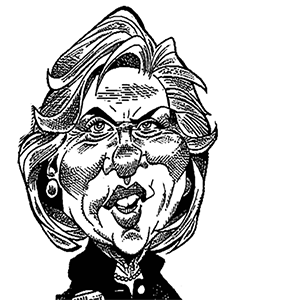How a shortage of visas for skilled workers is affecting the US economy
Published in Slideshow World
Subscribe
How a shortage of visas for skilled workers is affecting the US economy
People from all over the world have long come to the United States in search of opportunities. That includes immigrants, refugees and asylum seekers, and temporary workers and students who come to the U.S. on specialty visas.
Among the latter are skilled foreign workers, a select group granted special access by the H-1B visa program, designed to boost innovation and the economy via a "brain gain," according to the Brookings Institute.
Since launching in 1990, the program has allowed U.S. employers to hire exceptional foreign-born applicants with bachelor's degrees or the equivalent by offering them employment in hard-to-fill positions. An H-1B visa allows foreign-born workers to stay in the country for three years, with the option to extend their stay for up to six years. In some cases, workers remain even longer if employers sponsor their green cards. Most jobs filled by H-1B workers are in STEM (science, technology, engineering, and mathematics) fields.
H-1B visa holders tend to have wages within the top 10% of U.S. workers. In computer-related fields, for instance, the average annual income was $129,000 in 2022 for H-1B workers, according to the U.S. Citizenship and Immigration Services.
Congress has capped the number of H-1B workers since the program began; currently, around 85,000 applicants are accepted each year. Within that total, 20,000 spots are reserved for those with U.S. institution-issued master's or doctorates. That number has remained unchanged for nearly two decades—even as applications have dramatically risen and backlogs have made it increasingly difficult to get a visa.
From 2001 to 2003, the applicant limit was three times as high at 195,000; over the past 10 years, the program received such an influx of applicants it prompted Congress to institute a lottery system in 2014. Although exceptions to the cap are granted for nonprofit research organizations, the government, and colleges and universities, the number of applications far exceeds availability. In fiscal year 2025, for instance, there were an astounding 423,028 for just 65,000 spots.
Critics of the cap say that the inability for more workers to land positions in the U.S. creates a number of problems, one of which is a lack of qualified staff for the exploding tech sector.
H-1B Employer Data used its own data, news reports, and economic research to explore how a shortage of visas for skilled workers has impacted the U.S. economy.
Visit thestacker.com for similar lists and stories.
Visa workers drive growth of companies and economy
In 2024, Citizenship and Immigration Services changed the process for applying for an H-1B visa after 780,884 applications were filed that year. This process overhaul was meant to increase the odds of applicants vying for a spot and curb abuses of the system.
Employers and potential employees were gaming the system, hoping multiple submissions for individual workers would increase their likelihood of being accepted; the barrier to entry had also been lowered to a $10 fee and electronic registration instead of a full application.
Employers vying for top talent aren't the only ones benefitting from the H-1B visa program. Foreign workers tend to have different skill sets than American workers, which is partly why they're so sought-after. According to the American Immigration Council, workers from abroad may even help create additional jobs by spending and investing their earnings in the U.S. They stimulate the labor market by expanding operations in the U.S. and starting new businesses.
This entrepreneurial spirit, long a hallmark of U.S. innovation, drives economic growth.
"We don't know which [immigrant] is going to have the brilliant insight that totally transforms the economy over the next 20-30 years," David Bier, director of immigration studies at libertarian think tank the Cato Institute, told Vox.
Studies show that the business impact of the H-1B visa program extends beyond individual employers as well. A 2024 study from academic researchers and the Federal Reserve Bank of Richmond found that companies that win H-1B lottery visas hire additional employees, generate more revenue, and survive longer. In 2017, researchers at the National Bureau of Economic Research found that H-1B workers benefit consumers and increase profits in the IT sector.
Among the roughly 600,000 H-1B recipients in the country at any time, as many as 75,000 join the STEM workforce every year. Companies such as Amazon, Microsoft, and Intel, among the top 100 employers of H-1B workers, reap the rewards from foreign-born workers, who tend to fill in gaps in the STEM workforce—and in some cases, create opportunities. Employers, in turn, are eager to hire more H-1B workers to cultivate innovation and growth.
System loopholes and cap hamper further development
Other types of companies, including outsourcing firms, many based in India, also depend on H-1B workers. They are inundated with USCIS applications for employees they consider "interchangeable," according to Vox. These visa holders, typically junior programmers, will accept lower salaries and relocation requirements, and their hiring companies account for more than half of the top 30 H-1B employers.
There is concern, however, that these workers could be underpaid and exploited, giving some credence to the claim that the program allows lower-wage foreign workers to take jobs from higher-earning Americans.
However, existing data shows that H-1B workers help raise salaries and expand job opportunities for everyone. Employers of H-1B workers are also required to attest that U.S. workers' salaries and working conditions will not be negatively affected, and notify incumbent employees when they hire these applicants.
As evidenced by continued efforts to reform the system, there's still plenty of room for improvement. For every one person who is granted an H-1B visa, four are denied. This means the government—Congress sets the quota—leaves $61 billion on the table every year, according to a paper by Bier, who also suggested adjusting the cap to match demand, and making changes to maintain a sufficient population of skilled workers in the U.S.
In other words, the current cap on H-1B visas may actually thwart economic growth. Nine jobs are moved out of the U.S. for every 10 unapproved H-1B applications, according to a 2023 study from the University of Pennsylvania's Wharton School, as reported by Bloomberg. Some $86 billion would be lost with a 10% reduction in guest workers, according to a Federal Reserve Bank of Richmond economist.
Despite fraught debates over immigration and foreign-born workers, they have always been part of the uniquely American story of opportunity and improvement. As Jeremy Neufeld, a policy fellow with the think tank Institute for Progress, told Vox, "It's always been the case that immigrants have been a secret ingredient in US dynamism."
Story editing by Alizah Salario. Additional editing by Kelly Glass. Copy editing by Kristen Wegrzyn.
This story originally appeared on H-1B Employer Data and was produced and distributed in partnership with Stacker Studio.









Comments